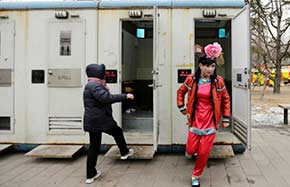Water from south China to reach more Beijingers by 2030
BEIJING -- Beijing will build a new water channel along its sixth ring road to deliver water from the Yangtze River basin to a larger population.
Construction of the "underground sixth ring," with designed water flow of 600 million cubic meters annually, is expected to begin around 2020 and be complete by 2030. It aims to transfer water to Beijing's suburban areas to help alleviate pressure from overpumping.
About 1.94 billion cubic meters of water has been transferred to Beijing since late 2014, when water diversion began via the middle route of the south-to-north water diversion project, directly benefiting more than 11 million people in the capital, according to the project office earlier this week.
The new route will bring water to a much larger part of the capital city.
"Almost all Beijing residents will be able to drink water from southern China when the new channel is open," said He Fengci, deputy director of the project office.
Affiliated facilities such as new water plants will also be set up.
Water transferred via the mega project has greatly eased pressure on water resources in Beijing. Recent data showed the water table of Beijing's plain in November rose 0.42 meter from a year ago, thanks to daily water flow of 3.4 million cubic meters from the project.
The water transfer project was conceived by Mao Zedong in 1952. The State Council approved the project in December 2002 after nearly half a century of debate.
Construction of the "underground sixth ring," with designed water flow of 600 million cubic meters annually, is expected to begin around 2020 and be complete by 2030. It aims to transfer water to Beijing's suburban areas to help alleviate pressure from overpumping.
About 1.94 billion cubic meters of water has been transferred to Beijing since late 2014, when water diversion began via the middle route of the south-to-north water diversion project, directly benefiting more than 11 million people in the capital, according to the project office earlier this week.
The new route will bring water to a much larger part of the capital city.
"Almost all Beijing residents will be able to drink water from southern China when the new channel is open," said He Fengci, deputy director of the project office.
Affiliated facilities such as new water plants will also be set up.
Water transferred via the mega project has greatly eased pressure on water resources in Beijing. Recent data showed the water table of Beijing's plain in November rose 0.42 meter from a year ago, thanks to daily water flow of 3.4 million cubic meters from the project.
The water transfer project was conceived by Mao Zedong in 1952. The State Council approved the project in December 2002 after nearly half a century of debate.
Related Stories
- Tears and smiles: Ordinary lives of Chinese people in 2016
- Two dead in Wednesday's terrorist attack in Xinjiang: police
- Chinese UN peacekeepers young and eager to break language barriers
- China to build more high-speed railways in five years: white paper
- China's high-speed rail on fast track in technology innovation and application
Editor's picks

















